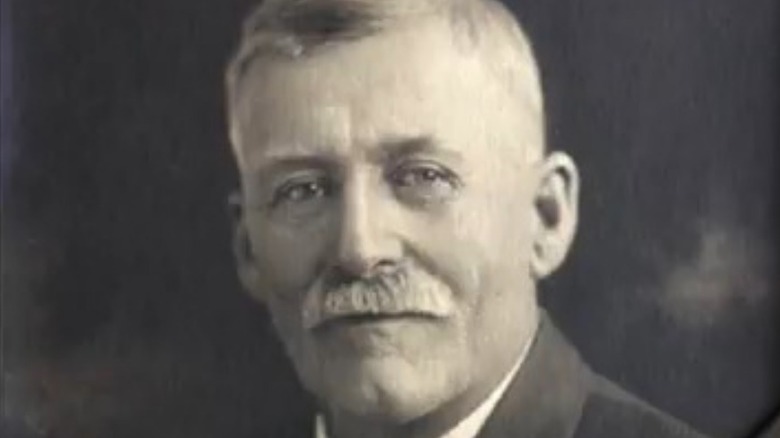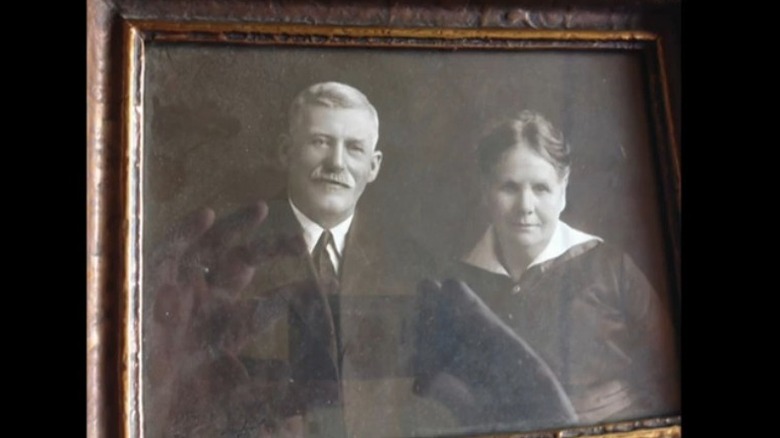The Oldest Active Missing Persons Case In America Explained
Even the most jaded true crime fan might be surprised to learn that the oldest missing persons case in the United States dates back nearly 100 years and involves a man who was born a whopping 164 years ago. Per the National Missing and Unidentified Persons System, or NamUS, 69-year-old Marvin Allen Clark was last seen on October 30, 1926, as he set out from his home in Tigard, Oregon where he planned to take a "motor stage" to visit his daughter in the city of Portland, Oregon. Described as around 5 feet, 7 inches tall, between 150 and 170 pounds, possibly wearing leather high-top boots, and walking with a "halting gait" due to being partially paralyzed on one side of his body, Clark never arrived in Portland and was reported missing.
According to a story from Oregon's KOIN 6 News, Clark was married to a woman named Mary and the couple had four children. Clark's disappearance made the local news, with The Oregonian newspaper describing the family embarking upon "a frantic search" and offering a $100 reward for any information. Marvin Allen Clark was further described as a "well-known resident of Tigard" who had lived in the town for 15 years, while the NamUS entry regarding his disappearance notes that he had also served as the town marshal of Linnton, Oregon, and knew the area above St. Helens Highway very well. Clark's great-great-granddaughter Pam Knowles grew up hearing stories about him from her own grandmother, who called him "adventurous."
A mysterious disappearance remains unsolved
Per her interview with KOIN 6 News, Pam Knowles grew up hearing about her great-great-grandfather Marvin Allen Clark's seemingly happy marriage and family life, telling reporters "The pictures of them together show them as being a very loving couple. They had at that time what I would consider probably a very nice home in Tigard. And my grandmother and her siblings always talked fondly of their grandfather." The mysterious disappearance continues to confound Clark's family as well as investigators; as Knowles mused during her interview, "I wonder who he was and why he left, or was there some sort of foul play? Or why did he leave the family and not come back again?"
A blog post by genealogist Duncan Kuehn at Genealogy Bank notes that Clark's family feared he had been killed by an enemy made during his years in law enforcement. The post also references a 1926 newspaper article in which Clark's daughter-in-law, the wife of his son Grover, had received a "disconnected" letter from Clark in early November that "indicated that the aged man's mind is wandering as it was badly jumbled despite the fact that Clark is highly educated, being a graduate of two universities." The article also reported that Clark had been spotted at hotels in Bellingham, Oregon on November 2 and 3.
Remains found near where Clark disappeared
The search for Marvin Allen Clark remained completely unsuccessful; not only was he never found alive, but his remains were never found either, hence the missing person case remaining open for as long as it has. But a good 60-years after Clark was reported missing, there seemed to be a break in the case.
In 1986, loggers came across very old skeletal remains while working in the hills above Oregon's Highway 30 (shown above). When investigators arrived, they also found coins within disintegrating clothes that dated back to 1919 as well as a corroded revolver lying next to the body. Investigators suspected the remains and items belonged to Clark, but they couldn't be sure.
Later, Multnomah County Sheriff's Sgt. Rian Hakala, the missing person detective for the sheriff's office, got involved in the investigation. According to Sgt. Hakala, "At the time, it was deemed a suicide, based on the police report," as reported by KOIN 6 News. A blog entry from writer and researcher Mary Hallberg notes that the skull of the man who had died contained a single bullet wound, which was deemed to be the cause of death.
A DNA sample brings hope ... and disappointment
Per KOIN 6 News, in addition to the coins and revolver, investigators also found remnants of old shoes, a pen engraved with "FOE," or Fraternal Order of the Eagles, and a pocket watch from Sears, Roebuck and Co. that indicated the remains had been there for quite a long time. The bones went to the local medical examiner's office and were stored there for years.
In 2014, Sgt. Hakala joined forces with state forensic anthropologist Dr. Nici Vance. Dr. Vance had DNA from the body discovered in 1986, and with the help of a genealogist, Hakala and Vance tracked down Pam Knowles and asked her for a DNA sample to determine if the remains did indeed belong to her great-great-grandfather, Marvin Allen Clark. Knowles agreed, telling KOIN "I started to think about, well, this would be kind of interesting to find out about this family member that went missing so long ago."
Both she and her son provided DNA swabs, and six months later, the results came back; the remains did not belong to Marvin Allen Clark. Hakala remains hopeful that Clark's remains will eventually turn up, musing "And who's to say he won't get found by a hunter or a landscaper or developer — or something like that happens. So, there's a chance he could be found." If he is, the department now has his descendants' DNA samples on file, ready to provide closure to this case.



